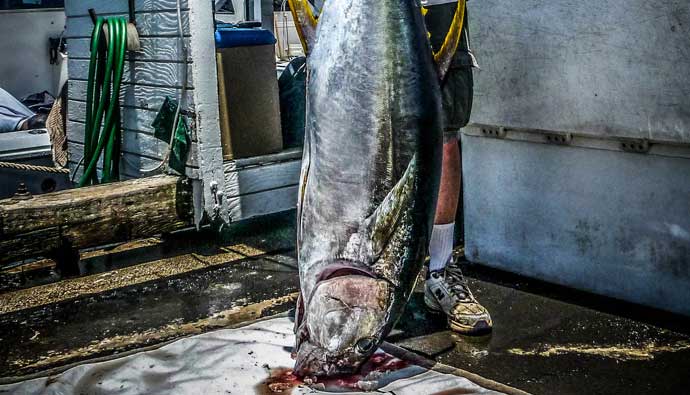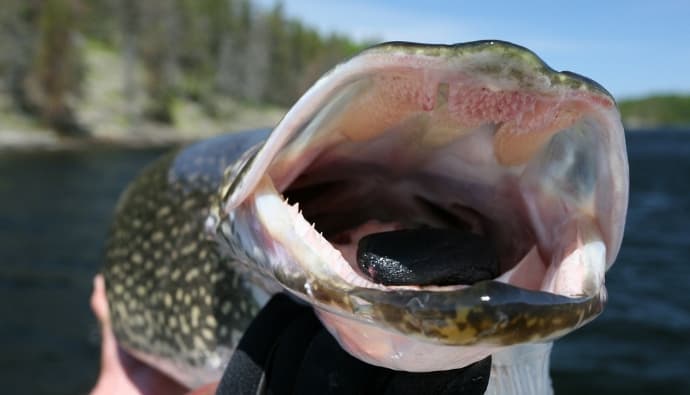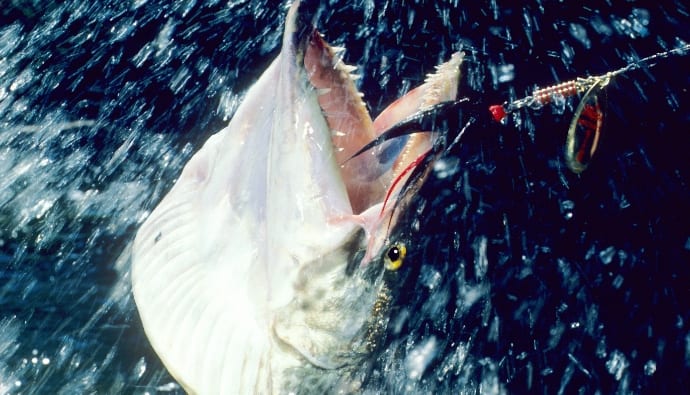Are you interested in yellowfin tuna fishing?
Before we jump into how to catch them, let’s get the know this beautiful fish better.
Listen to How to Spear for Tuna in SoCal on the Cast & Spear Podcast
Overview
This fish is also known as ahi, Allison tuna, and Pacific yellowfin. This speedy fish has long been coveted as a sportfish that gives as good as it gets.

These are fairly abundant in tropical waters (in the Pacific, Atlantic, and Indian Oceans) and the young ones are known for creating large schools for protection. In this guide, you’ll learn a little about the fish, how to catch them, and how to enjoy preparing them.
Yellowfin Tuna Facts
Yellowfin is considered to be the most colorful out of all the tuna species. The back is a gorgeous blue/black and fades to silver on the belly and lower flanks. Blue or yellow stripes run from the eyes to the tail and all the fins are golden yellow in color as its namesake.
Adult yellowfin usually remain in deep water, but anglers often find some close to the surface. The fish often mingles with other species such as the bigeye tuna, and they can reach close to 40-inches in length. It spawns throughout the year in areas where it is abundant and is at its most active during the summer months.
According to the ISSF Scientific Advisory Committee, yellowfin tuna in the Eastern Pacific and the Indian Ocean are threatened due to overfishing.
| Common Name | Yellowfin Tuna |
| Scientific Name | Thunnus albacares |
| Family | Scombridae |
| Identifying Characteristics | Torpedo shaped body with dark metallic blue/black backs, silver belly, and yellow fins. |
| Depth Range | 1 to 250 meters |
| Fishing Information | Found in the warm waters of the Pacific, Indian, and Atlantic Oceans. |
| Size Limits | Minimum size is 27 inches per tuna. |
| Catch Limits | Check your local regulations |
Yellowfin Tuna Fishing Tips
Yellowfins are ideal targets for trollers and bait anglers as well. If you are the former, use artificial lures, small squid, ballyhoo fish, and strip baits to lure the fish to your hook. Chumming and live bait fishing also helps in deep waters especially if you cast your line offshore.
The tackle you use should be scaled according to the size of the yellowfin you are targeting. For instance, use a tackle that is as light as 15lbs for small schools but uses heavier ones for adult varieties.

When it comes to the best yellowfin tuna gear, you cannot go wrong with composite rods and especially those that are made of a combination of fiberglass and graphite. These have the strength to handle adult yellowfins and are not as heavy compared to pure fiberglass tuna rods.
How to Catch Thunnus albacares
- The yellowfin often feeds near the surface of the water so use topwater techniques to catch them. Since they can see well, use fluorocarbon leader to reduce visibility and reduce abrasion.
- If you are trolling, use cedar plugs, tuna feathers, or plastic trolling lures that are blue or white in color. Plus, by using double hooks you can prevent the yellowfin from escaping your line since they are difficult to bend or shake off.
It’s recommended to go with circle hooks to reduce the chance of them unhooking.

Fishing Tips
- If you are unable to locate schools of yellowfin tuna go into stealth mode by shutting off the boat’s engine and the generator. A lot will swim up if you have set out bait.
- Yellowfin can be found in large schools around the up-current and sub-currents on the sides of oil rigs.
- The deeper you are fishing, the larger the tuna you can catch. Make sure that you get a good feel for the weight of the tuna that is on your line or you may lose it.
Spring, Summer, Fall, and Winter Seasons
The best time to catch yellowfin tuna depends on the location and the time of year. For instance in Costa Rica, the best time to fish for it is between May and November during the rainy season. The tuna starts to show up there during May and peaks during June, July, and August.
Similarly, the tuna season in Panama starts in March, and the fish increases in size till April when the dry season ends. The season peaks during June, July, and August there as well after which the fish starts to reduce in size again.
The best way to find them irrespective of your location is to look out for diving birds and schools of spinner dolphin that travel on top of the tuna.
How to Clean Tuna

- Cut behind the head at a 45° angle to save as much meat as you can.
- Make a 2 inches deep cut along the backbone.
- Cut across the body of the tuna near the tail and then make a 2 inches deep cut in the center of the belly.
- Enlarge the cuts made in the back and the belly to the backbone and repeat on the other side.
- Make another cut down the length to the backbone and just above the lateral line on the side.
- Free the top loin by cutting off the flesh from the fish carcass.
- Make another cut down below the lateral line down the side of the fish. Take off the lower loin from the carcass and make a finger hole through the flesh and skin and hold it while you cut.
- Flip the loin on the cutting surface skin down and remove it by running your knife between the skin and the flesh.
- Remove and discard blood-lined meat and cut each loin into steaks.
How to Prepare Ahi Ahi Sashimi

Ahi Recipe – How to Cook
- Use a fork to poke holes into the yellowfin tuna steaks and place them in s shallow glass dish.
- Make a mixture of half a cup of vegetable oil, 1/3 cup soy sauce, 2 tsp Dijon mustard, 1 tsp grated lemon peel, and 1 clove of crushed garlic.
- Spread the mixture on the tuna steaks, cover, and place the dish in the refrigerator for a couple of hours.
- Preheat the grill to medium and oil it lightly.
- Shake excess marinade from the steaks and pour it into a separate saucepan to boil. Cook at a simmer for 10 minutes after it starts to boil.
- Cook the tuna on the preheated grill and baste with the cooked marinade for 5 minutes on each side.
- Serve with lemon wedges.
Frequently Asked Questions
Q. What do yellowfin tuna eat?
A: At a young age, this fish feeds on tiny zooplankton and adults prey on large, bony fish and squid.
Q. What do yellowfin tuna look like?
A: This tuna species has a torpedo-shaped body, a dark metallic back, yellow sides and fins, and a silver belly.
Q. What is the lifespan of this tuna species?
A: Yellowfin tuna can live up to 6 to 7 years of age.
Insider Advice
While spearfishing for yellowfin tuna, try ascending while you still have breath. That is the best way to make a school come right under you when it is just out of range and is not coming closer.
If you see a large tuna swimming in a straight path and it is unaffected by your presence, position yourself directly above the fish and dive down at them in a straight line as fast as you can to catch it by surprise.




 Facebook
Facebook YouTube
YouTube








